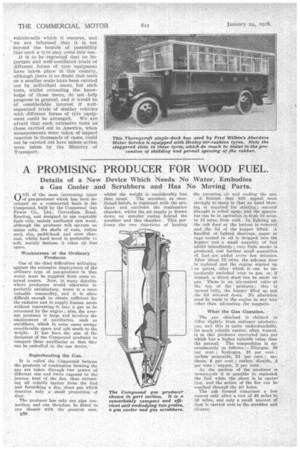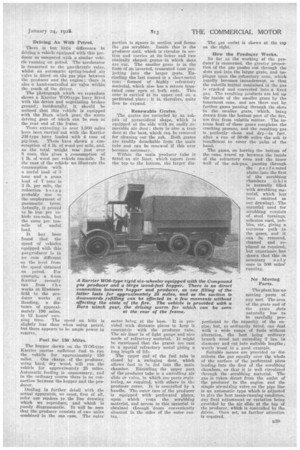A PROMISING PRODUCER FOR WOOD FUEL.
Page 56

Page 57

If you've noticed an error in this article please click here to report it so we can fix it.
Details of a New Device Which Needs No Water, Embodies a Gas Cooler and Scrubbers and Has No Moving Parts.
ONE of the most interesting types of of which has been developed on a commercial basis is the Compound, built by the Compound Gas Power Co., 'Ltd., Caversham Road, Reading, and designed to use vegetable fuels only, mainly untfeated raw wood; although the producer will operate car maize cobs, the shells of nuts, Cotton seed, rice, paddi-husk and Olen charcoal, whilst hard wood is preferable to soft, mainly because it takes up less' space.
Weaknesses of the Ordinary Producer.
One of the chief difficulties militating against the extensive 'employment of th ordinary type of g-aMproducer is that water must be supplied from some ex ternal source. Now, in many districts where producers would otherwise be perfectly satisfactory, water is a most valuable commodity, and it is often difficult enough to obtain sufficient for the radiator and to supply human needs without Converting it into a gas to be consumed by the engine ; also, the average. producer is large and involves the employment of auxiliaries, such as scrubbers, which in some cases occupy considerable space and add much to the weight. It has been the aim of the designers of the Compound producer to compact these auxiliaries so that they can be embodied in the one device.
Superheating the Gas.
It is called the Compound because the products of combustion forming the gas are taken through two grates of different size and twice exposed to the intense heat of the fire, thus extracting all volatile matter from the fuel and furnishing a dry, clean gas which dontains only a small proportion of dust.
The producer has only one pipe connection, and can therefore be fitted to any chassis with the greatest ease, whilst the weight is considerably less
than usual. The scrubber, as mentioned before, is cOmbined with the producer and encircles the combustion chamber, whilst the air supply is drawn down an annular casing behind the scrubber and this chamber. This performs the two functions of heating
the incoming air and cooling the gas.
A feature that will appeal most strongly to many is that no baud blowing is required for .starting; natural draught is relied up, and the apparatus can be in operation in from 10 mins. to 15 mins, from cold. In lighting up, the ash door at the bottom is removed and the lid of the hopper lifted. A handful of lighted shavings, paper or rags soaked in oil is dropped into the hopper and a small quantity of. fuel added immediately ; very little smoke is produced, and further small quantities of fuel are added every few minutes. After about 12 mins. the ash-pan door is replaced and the engine started up on petrol, ilitet which it can be immediately switched over to gas, or, if desired, a direct start can be made on gas. There is an air-control valve at the top of the producer ; this is opened folly, the hopper filled up and the lid screwed down. No alteration need be made to the engine in any way other than advancing the magneto.
What the Gas Contains.
The gas obtained is claimed to differ slightly from ordinary producergas, and this is quite understandable, for much yolatile matter, often wasted, is in this producer, converted into gas which has a higher calorific value than the normal. The composition is approximately as follows :--Nitrogen, 48 per Cent,; hydrogen, 18 per, cent. ; carbon monoxide, 24 per cent.; methane, 4 per cent. ; carbon • dioxide, 4 per cent.; oxygen, 2 per cent.
As the suction of the producer 35 downwards it is possible to replenish the fuel while the plant is in opera" tion, and the action of the fire can be watched through the air holes.
The ash formed comprises a few ounces only after a run of 40 miles to 50 miles, and only a small amount of dust is carried over to the scrubber and cleaner.
Driving As With petrol.
There is but little difference in driving a vehicle equipped with this producer as compared with a similar vehicle running on petrol. Theaccelerator is connected to the gas-throttle valve, whilst an automatic spring-loaded ,air valve is fitted on the gas pipe between the producer and the engine.; there is also a hand-controlled air valve within
the reach of the driver.
The photograph which we reproduce shows a Karrier WOO-type lorry fitted with the device and negotiating broken ground ; incidentally, it should be noticed. that this vehicle is equipped with the Burn winch gear; the worm driving gear of which can be seen at the rear end of the frame.
Pests extending to over 1,000 miles have been carried out withthe Karrier JH-type lorry loaded with 4 tons of pig-iron. These have shown a constimption of 4 lb. of wood per mile, and, as the total weight was just over 8 tons, this gives a .consumption of 4. lb. of wood per vehicle ton-mile. In the case of the vehicle we illustrate the consumption with a useful load of 3 tons and a gross load of 7 tons is 3 lb. per mile, the reduction b eing probably due to the employment of pneumatic tyres. Actually, it proved to be less per vehicle ton-mile, but the same per tonmile of useful load.
• It has, been found that the speed of vehicles equipped with this gas-producer ie in no ease different onthe level from the speed obtained on petrol. For example, -a 4-ton Karrier recently ran from t h e works at, Huddersfield to the producer works at Reading, a distance of approximately 190 miles, in 12 hours' running time. The speed on hills is slightly less than when using petrol, but there appears to be ample power in reserve.
Fuel for 150 Miles.
The hopper shown on the WOO-type Karrier carries sufficient fuel to run the vehicle for approximately 150 miles.. One charge of the producer, ueing hard, dry wood, will run the vehicle for approximately 25 miles. Automatic feeding is unnecessary, and in the ordinary course there is no connection between the hopper and the pro&wee
Dealing in further detail with the actual apparatus, we must, first of all, refer our readers to the line drawing which we reproduce, and which is purely diagrammatic. It will bethat the producer consists of two nits combined in the one case. The outer'
portion is square in section and forms the gas scrubber. Inside this is the producer unit, which is•eircular in section and carries at its lower end two conically shaped grates in which slots are cut. The smaller grate is in the form of an inverted, truncated cone projecting into the larger grate. Encircling the last named is a sheet-metal cone formed of highly refractory material, which also has a return truncated cone open at both ends. This Cone is carried at its upper end on a perfOrated plate ; it is, therefore; quite free to expand. •
Renewable Grates. •
. The grates are encircled by an ashpan of pyramidical shape Which is equipped at the side with an easily yeMovable air door ; there is nIso a, trap-door. at the base, which can be removed for cleaning out the ash. Both grates are readily detachable from the main tube and can be renewed if this ever becomes necessary.
Within the main producer tubeis fitted an air liner, which tapers from the top to the bottom, the larger die
meter being at the base. It is provided with distance pieces to keep it concentric with the producer tube. The air liner is of light gauge and also made of refractory material. It might be mentioned that the grates are cast in a special refractory metal giving a long length of life.
The upper end of the fuel tube is closed by a swinging door, which allows fuel to be fed into the main chamber. Encircling the upper part of the producer tube is a swivelling air slide or valve, in Which are ports registering, as required, with others in the producer cover. It is controlled by a handle. The outer case of the producer is equipped with perforated plates, upon which rests the scrubbing material, and access to this material is obtained through 'doors conveniently situated in. the aides of the outer casing.
The gas outlet is shown at the top on the right.
How the Producer Works.
So far as the working of the producer is concerned, the greater proportion of the gas pastes out through the slots and into the larger grate, and impinges upon the refractory cone, which rapidly becomes incandescent, so that the volatile matter contained' in the gas is cracked 'and converted into a fixed gas. The resulting products are led up the inside of the smaller grate by the innermost cone, and are there met by further gases passing through the slots in the smaller grate, which, being drawn from the hottest part of the fire, are free from volatile matter. The intense heat of -these gases completes the cracking process, and the resulting gas is perfectly clean and dry—in ''fact. after a run of 50-60 miles the ash is insufficient to cover the palm of the hand.
The gases, on leaving the bottom of the cone, travel up between the inside of the refractory cone and the inner wall of the ash-pan, passing through the perforated
plates into the first of the scrubbing chambers (this is normally filled with scrubbing material, which has been omitted in our drawing). The material used for scrubbing consists of steel turnings, asbestos cord, pebbles, etc., giving a tortuous path to the gases, and it can be removed, cleaned and replaced as required, but experience has shown that this is necessary only once in 500 miles' running.
No Moving Parts.
The plant has nei moving parts of any sort. The area of the grate and of the grate slots naturally has to be carefully proportioned to the capacity of the engine, but, as ordinarily fitted, can deal with a wide range of fuels without alteration, the best being ordinary branch wood not exceeding 2 ins. in diameter and cut into suitable lengths; wattle wood is a good example.
Suitable means are provided to dietribute the gas equally over th,e whole of the surface of the perforated plate leading into the first of the scrubbing chambers, so that it is well circulated through the scrubbing material. The gas is taken direct from the outlet of the producer to the engine and the simple air-mixing valve on the pipe line is an automatic type which is adjusted to give the best mean-running condition, any final adjustment or variation being Provided by the air slide at the top of the producer, which is controlled by the driver, Once set, no further attention is required.




































































































